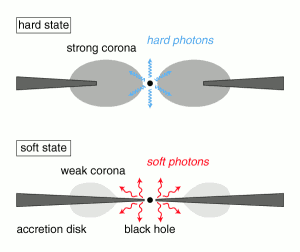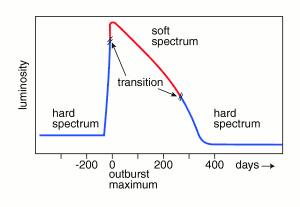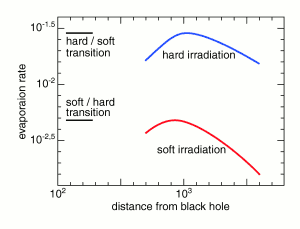|
|  |
Of great interest for the researchers are the properties of the matter flow
towards a black hole (black holes of stellar mass or supermassive black holes
in the centers of galaxies). Due to its angular momentum the
infalling gas spirals inward. Close to the compact object this can
happen either in form of a thin accretion disk or as a more spherical
hot flow (Fig.1).
Farther away from the center always the former one is present.
We here discuss the accretion flows observed for low-mass X-ray
binaries, close binary stars where one is a black hole or a neutron
star. The spectrum
of the observed X-ray light is different for the two accretion modes:
(1) a very hard spectrum (up to 100 keV) originates from the very
energetic particles of hot flow or
(2) a soft spectrum (a few keV) which is radiated from the much less
hot thin accretion disk. The radiation from the region close to the black
hole dominates the spectrum.
A special feature of the observed spectra is the change between the two
types. During the long lasting "quiescent" phases of the binaries the
spectrum is hard. This means that at a certain distance from the black hole
the disk accretion which is commonly the mode further out, turns into the
hot 'coronal" flow (the word "corona" is used in comparison with the
solar corona, where we
recognise the hot flow as a crown around the sun during a solar
eclipse). Taking into account the physics of the interaction between
disk and corona we can determine which amount of gas evaporates from
the thin cool disk to the coronal hot flow and at which distance from
the black hole finally all matter has entered the hot flow. This
distance depends on the mass flow rate in the cool disk.
The lower this mass flow rate is the larger is the distance
where the the thin cool disk is truncated. The coronal evaporation
reaches a maximum at a certain distance from the black hole. If the
mass flow rate in the accretion disk is larger than this maximum the
disk can no longer be completely evaporated and instead contimues all
the way to the central black hole finally carrying nearly all of the
accreting mass again. The radiation is now from the cool inner disk
surface and the spectrum becomes soft. Therefore with increasing
and decreasing mass flow as occuring during an X-ray novae outburst
(Fig. 2) the accretion mode changes and simultanously the spectrum
from hard to soft and back to a hard one.
If now we follow the lightcurve during an outburst we see that these
changes hard-soft and soft-hard do not occur at the same luminosity or
mass accretion rate. Instead the second transition occurs
at a luminosity lower by a factor of about 3 to 5. Where does this
unexpected difference come from? The surprising phenomenon
can now be understood: The rate of mass evaporation depends on the
radiation from further in, either hard from the hot flow at the time
of the change from hard to soft state, or soft from the much cooler
thin disk in the inner region at the time of the reverse change, as
shown in Fig.3.
F. Meyer, E. Meyer-Hofmeister, B.F. Liu
Further information:
E. Meyer-Hofmeister, F. Meyer, B.F. Liu, Astronomy & Astrophysics, March 2005, volume 432, Issue 1, pp.181-187
( astro-ph/0411145) astro-ph/0411145)
|


